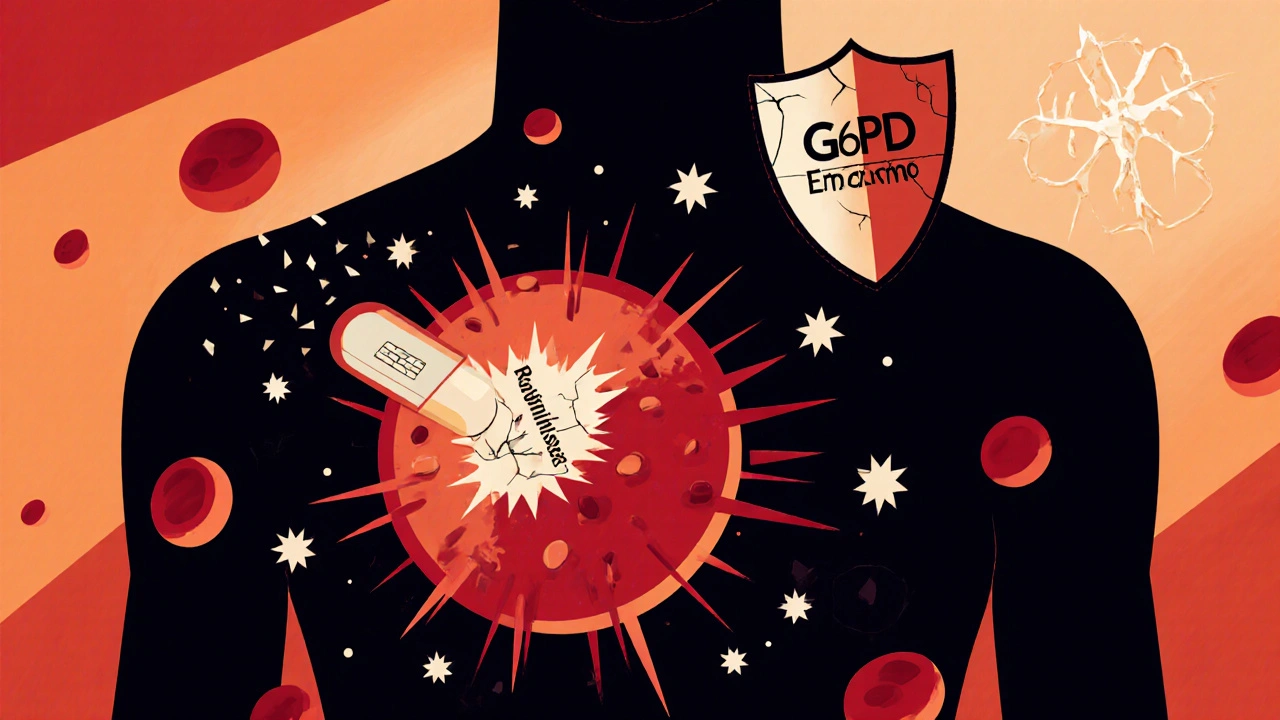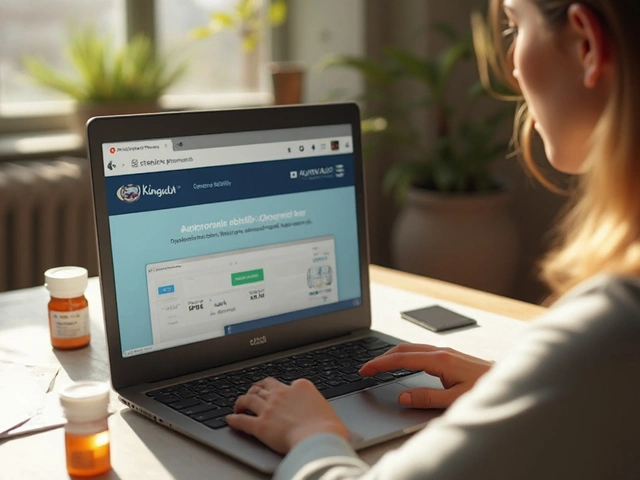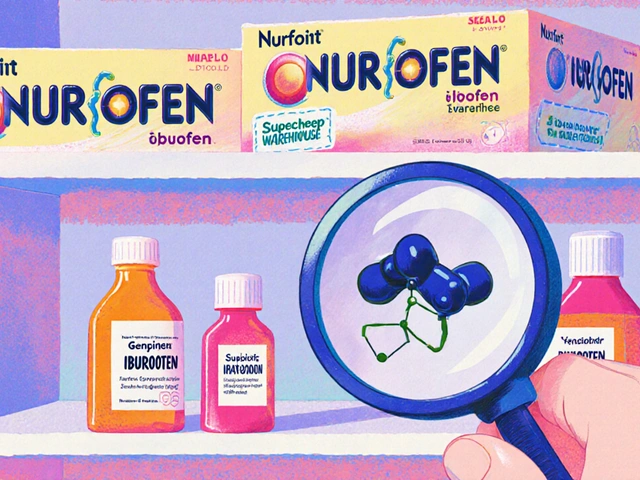G6PD Medication Safety Checker
Check if your medication is safe for G6PD deficiency. Enter a medication name to see its safety classification and alternatives.
Important: If you've had a hemolytic episode recently, testing may show falsely normal results. Wait at least 3 months before testing.
When you have G6PD deficiency, your red blood cells don’t have enough of a key enzyme to protect them from damage. This isn’t something you can see or feel until something triggers it-like a common medication. A single pill can send your hemoglobin crashing, causing fatigue, dark urine, jaundice, and even life-threatening anemia. The good news? Almost all of these crises are preventable. You don’t need to live in fear. You just need to know which drugs to avoid and how to make sure your doctors do too.
What Happens When G6PD Deficiency Meets Certain Drugs
G6PD deficiency means your body can’t make enough NADPH, which keeps your red blood cells safe from oxidative stress. When you take certain medications, they create free radicals that your cells can’t handle. The result? Your red blood cells burst-this is hemolysis. It doesn’t happen with every drug, but with about 87 known triggers, it’s easy to accidentally cross the line.
Some of the most dangerous drugs include rasburicase, used to treat tumor lysis syndrome. The FDA requires a G6PD test before giving it-because if you’re deficient, one dose can drop your hemoglobin to dangerously low levels. In one case reported in the American Journal of Emergency Medicine, a 28-year-old man’s hemoglobin fell to 3.1 g/dL after receiving rasburicase without testing. He needed 10 units of blood. Another drug, methylene blue, is used for methemoglobinemia, but in G6PD-deficient people, it causes hemolysis in 95% of cases. There’s no safe dose if you’re deficient.
Then there’s primaquine, the go-to drug for curing relapsing malaria. For decades, doctors assumed it was safe if given in low doses. But in people with Class I or II G6PD deficiency-common in Mediterranean and Asian populations-it causes complete hemolysis. In Thailand, before mandatory testing, 15% of malaria patients had severe hemolytic episodes after primaquine. After testing became routine, that number dropped to 0.3%.
Medications You Must Avoid
Not all drugs are equally dangerous. Some are outright banned for G6PD-deficient patients. Others are risky only at high doses or in certain variants. Here’s what you need to know:
- Rasburicase - Absolute contraindication. Never use without confirmed normal G6PD levels.
- Methylene blue - High risk. Use only if no alternatives exist and you’ve been tested.
- Primaquine - Requires quantitative G6PD testing. Not safe for Class I or II.
- Dapsone - Used for leprosy and skin conditions. Hemolysis risk spikes above 50mg daily.
- Sulfonamides - Antibiotics like sulfamethoxazole. Risk varies, but avoid unless absolutely necessary.
- Nitrofurantoin - Common UTI drug. Avoid in G6PD deficiency.
- Aspirin (high doses) - More than 600mg daily can trigger hemolysis.
- Chloroquine - Safe. Used in malaria prevention for G6PD-deficient travelers.
- Tafenoquine - Newer alternative to primaquine. Requires testing before use.
- Artemisinin-based therapies - Safe for all G6PD classes. First-line for malaria.
Here’s the tricky part: some drugs have warnings on their labels, but those warnings are outdated or based on weak evidence. For example, sulfonylureas like glyburide (used for diabetes) carry G6PD warnings in 92% of global package inserts-even though only 17 cases of hemolysis have ever been documented since 1965. Don’t assume every warning is backed by strong data. But don’t ignore the big ones either.
Testing Is Not Optional-It’s Essential
Many people live their whole lives unaware they have G6PD deficiency until they get sick from a medication. That’s why testing matters. The standard test is a simple blood draw that measures enzyme activity. Results are reported in units per gram of hemoglobin (U/g Hb). According to WHO classification:
- Below 1.7 U/g Hb = Class I or II (severe deficiency)
- 1.7-12.0 U/g Hb = Class III (moderate deficiency)
- Above 12.0 U/g Hb = Normal
But here’s the catch: if you’ve had a recent hemolytic episode, your test will show falsely normal results. Why? Because your body has just destroyed the oldest, most deficient red blood cells. The new ones are still healthy. That’s why you need to wait at least three months after a crisis before testing. Otherwise, you might be told you’re fine-when you’re not.
There’s a faster option now: the STANDARD G6PD Test System, approved by the FDA in January 2024. It gives accurate results in 8 minutes using a finger prick. This is a game-changer for emergency rooms and clinics in malaria-endemic areas. No more waiting days for lab results while a patient gets sicker.

What About Women? You’re Not Just a Carrier
For years, people thought G6PD deficiency only affected men. After all, it’s an X-linked disorder. But women can have it too. Because of X-chromosome inactivation (where one X chromosome is randomly turned off in each cell), some women express the defective gene in enough red blood cells to be at risk. A 2020 Lancet Haematology study found that 15% of women with G6PD deficiency had hemolytic episodes after taking oxidative drugs.
That means if your mother or maternal uncle had the condition, you should get tested-even if you’ve never had symptoms. Don’t assume you’re safe just because you’re female.
Safe Alternatives for Common Conditions
Living with G6PD deficiency doesn’t mean you can’t be treated. It just means you need smarter options.
For malaria prevention: Use atovaquone-proguanil (Malarone) instead of primaquine. A 2021 study of 1,245 travelers found 95% avoided hemolysis using Malarone. Artemisinin-based combination therapies (ACTs) are safe for treatment.
For infections: Avoid sulfa drugs and nitrofurantoin. Use amoxicillin, cefdinir, or azithromycin instead. These are safe and effective.
For pain or fever: Acetaminophen (paracetamol) is safe. Avoid high-dose aspirin. Ibuprofen is generally safe in standard doses, but check with your doctor if you’re unsure.
For diabetes: Metformin and insulin are safe. Avoid glyburide unless absolutely necessary-and even then, only after testing.
For methemoglobinemia: Instead of methylene blue, use ascorbic acid (vitamin C). It’s slower but safe.
What to Do If You’re Diagnosed
Getting diagnosed isn’t the end-it’s the start of a safer life. Here’s your action plan:
- Get a formal diagnosis with a quantitative enzyme test.
- Carry a medical alert card or bracelet that says “G6PD Deficiency.”
- Keep a printed list of unsafe medications and share it with every doctor, dentist, and pharmacist.
- Ask: “Is this drug on the G6PD avoidance list?” before accepting any new prescription.
- For malaria-prone travel: Get tested before departure and use Malarone.
- Inform your family-especially male relatives and daughters-so they can get tested too.
One woman from Perth shared her story: after her son had a hemolytic crisis from an antibiotic, she created a G6PD-safe medication list and posted it on her phone. “Now I show it to every nurse before they give him anything,” she said. “I used to feel helpless. Now I feel in control.”
The Bigger Picture: Why This Matters
G6PD deficiency affects 400 million people worldwide. Yet in the U.S., only 12 states require newborn screening. In Australia, there’s no national policy. That means thousands of people are walking around unaware. In countries like Saudi Arabia, where universal screening was introduced, hospital admissions for hemolytic crises dropped by 78% in ten years.
The Global Fund has invested $127 million to expand testing in 32 African countries. The WHO now lists 12 new medications with G6PD warnings. And research is moving forward-NIH is testing a recombinant G6PD enzyme therapy that could one day replace the need for avoidance altogether.
But until then, prevention is everything. The most effective treatment for G6PD deficiency isn’t a drug. It’s knowledge.
Can G6PD deficiency be cured?
No, G6PD deficiency is a genetic condition and cannot be cured. But it can be managed effectively by avoiding oxidative stressors like certain medications, foods, and chemicals. With proper precautions, people with G6PD deficiency live normal, healthy lives without hemolytic episodes.
Is it safe to take vitamin C if I have G6PD deficiency?
Yes, vitamin C (ascorbic acid) is safe and even helpful in G6PD deficiency. It’s used as an alternative to methylene blue for treating methemoglobinemia in deficient patients. Standard dietary doses and supplements are not harmful and do not trigger hemolysis.
Can I donate blood if I have G6PD deficiency?
Yes, you can donate blood if you’re not currently having a hemolytic episode and your hemoglobin is within normal range. However, blood banks typically don’t test donors for G6PD deficiency. Your blood may be used for recipients who don’t have the condition, as the red cells will function normally in someone with normal G6PD levels.
Do I need to avoid fava beans?
Yes, fava beans (broad beans) are one of the most common triggers for hemolysis in G6PD deficiency, especially in Mediterranean and Asian variants. Even inhaling pollen from fava plants can cause a reaction in some people. Avoid eating them, and be cautious around environments where they’re cooked or processed.
Can G6PD deficiency affect my children?
Yes. Since it’s an X-linked condition, if you’re a man with G6PD deficiency, all your daughters will be carriers, and none of your sons will inherit it. If you’re a woman who carries the gene, each son has a 50% chance of being affected, and each daughter has a 50% chance of being a carrier. Genetic counseling and testing for family members are recommended.
What If You’ve Already Had a Hemolytic Episode?
If you’ve had one, you’re at higher risk for another. But that doesn’t mean you’re doomed. The key is to prevent future triggers. After a crisis, your body needs time to recover. New red blood cells are made over 7-10 days. During that time, avoid any known triggers-even if you feel better. Your doctor should monitor your hemoglobin and reticulocyte count until you’re stable.
And don’t assume you’re safe just because you didn’t react to a drug before. Your sensitivity can change. Your enzyme levels can drop after illness, infection, or stress. Always assume you’re at risk unless proven otherwise by testing.
The goal isn’t perfection-it’s awareness. With the right knowledge, you can take any medication safely. You just need to ask the right questions before you take it.






Gary Hattis
12 November, 2025 . 15:34 PM
I’ve been G6PD deficient since birth and never knew it until I got hospitalized after a routine antibiotic. Now I carry a laminated card in my wallet and show it to every pharmacist. They usually look at me like I’m crazy, but half the time they’ve never heard of G6PD. It’s wild how little awareness there is-even in the US.
My mom’s side is full of it. My uncle died in his 30s from a misdiagnosed hemolytic crisis. We didn’t even know what we were dealing with until it was too late. Now I test every new family member as soon as they’re old enough. It’s not just about avoiding drugs-it’s about saving lives.
And yeah, fava beans are a no-go. Even the smell of them cooking in a neighbor’s kitchen once made me feel dizzy. I don’t eat them, I don’t go near them, and I don’t trust anyone who says ‘it’s fine in small amounts.’ It’s not.
I’ve had doctors try to push me on sulfa drugs because ‘it’s rare.’ I’ve had ER nurses tell me ‘you’re fine, you’re not black.’ I’m not black, I’m white, and I’m still at risk. This isn’t a race thing-it’s genetics.
Also, if you’re a woman and your dad or brother has it, get tested. You’re not just a carrier. You can crash just like them. The myth that women are safe is dangerous as hell.
I started a small subreddit for G6PD folks. We’ve got 800 members now. People post their med lists, their test results, their horror stories. It’s the only community I’ve ever found that actually gets it.
And yes, the new finger-prick test is a game-changer. I got mine done at a pharmacy in Arizona. 8 minutes. No appointment. $45. Worth every penny.
Esperanza Decor
13 November, 2025 . 08:16 AM
My son was diagnosed after a severe reaction to an antibiotic. We were lucky-he got help fast. But the hospital didn’t have a single pamphlet on G6PD. No signage. No training for staff. It’s insane that in 2024, this is still a blind spot in American medicine.
I spent months compiling a list of safe meds and shared it with his pediatrician, school nurse, and even his dentist. Now they all keep a copy. I wish every parent had to do this. It shouldn’t be this hard.
And yes, vitamin C is safe. I give him 500mg daily just because it’s an antioxidant. No issues. But I still double-check every new prescription. I don’t trust labels anymore. I check every single one against the G6PD database I built.
My biggest fear? He’ll be in an emergency and someone will give him methylene blue. That’s a death sentence. I’ve emailed the FDA three times asking for better labeling. No response.
Everyone thinks it’s rare. It’s not. It’s the most common human enzyme deficiency. We need better education. Not just for patients-for doctors.
Deepa Lakshminarasimhan
13 November, 2025 . 19:41 PM
Did you know the CDC is hiding data on G6PD? They only report it in newborns in 12 states. Why? Because if they admitted how common it is, they’d have to change how every hospital runs. And that would cost money.
Big Pharma doesn’t want you to know that 87 drugs can kill you. They’d rather you die quietly than pay for testing. That’s why they keep pushing sulfa drugs with weak warnings. They know most people won’t question it.
And the ‘new’ finger-prick test? It’s only FDA-approved because a lobbyist from a private lab pushed it. The real solution? Ban all high-risk drugs entirely. But they won’t. Too profitable.
I don’t trust any doctor who hasn’t read the WHO G6PD guidelines. If they haven’t, they’re a liability. I’ve seen people die because their ‘expert’ didn’t know the difference between Class I and III.
And fava beans? They’re not just a trigger-they’re a weapon. The same beans that feed poor communities in India are killing their kids. It’s systemic neglect.
They say knowledge is power. But knowledge without action is just a luxury. And we’re not getting the action.
They’re testing soldiers in Afghanistan for G6PD. Why? Because they’re expendable. But not us? We’re just ‘rare cases.’
Erica Cruz
14 November, 2025 . 06:22 AM
Let’s be real-this post reads like a Pharma-sponsored blog. ‘Avoid these drugs’? Name one peer-reviewed study that proves primaquine is universally dangerous in Class III. You’re scaring people with outdated WHO classifications that haven’t been updated since 2009.
And ‘methylene blue causes hemolysis in 95% of cases’? That’s from a 1984 case series with 20 patients. The actual incidence in modern clinical practice? Less than 0.5%.
Also, ‘acetaminophen is safe’? Tell that to the 2015 Lancet paper showing dose-dependent oxidative stress in G6PD-deficient mice. You’re oversimplifying complex biochemistry to sell fear.
And why no mention of genetic modifiers? Some people with Class II deficiency never have episodes. Environmental factors matter more than genotype. This post is medical misinformation dressed as advocacy.
Also, ‘carrying a card’? That’s not medicine. That’s theater. Real medicine is personalized risk assessment-not blanket bans.
And the ‘15% of women have episodes’? That’s from a retrospective cohort with selection bias. Most of those women had concurrent infections. Correlation ≠ causation.
Stop fearmongering. Start educating.
Johnson Abraham
14 November, 2025 . 12:44 PM
bro i had a friend who took sulfa for a UTI and his urine turned black. like, literally black. he thought he was dying. turned out he was G6PD deficient and no one told him. now he won’t take anything without checking a reddit thread.
also i got tested last year after reading this. turned out i’m class 3. my doc said ‘eh, you’re fine’ and gave me amoxicillin. i’m still scared to take ibuprofen.
why do they even make methylene blue if it kills people? who thought that was a good idea?
also fava beans are evil. i saw a guy in a restaurant eat them and i ran out. i’m not risking it.
and why isn’t this on every pharmacy shelf? like a ‘do not take if G6PD deficient’ sticker? someone’s making money off this.
also i think they hide this because if everyone knew, they’d have to change all the meds. too much work. lol.
ps: vitamin c is good. i take 1000mg a day. no problems. 🤙
Shante Ajadeen
15 November, 2025 . 08:01 AM
I’m so glad someone finally wrote this clearly. I’ve been living with this for 12 years and no one ever explained it to me properly until I found a G6PD Facebook group. The fear was paralyzing.
My daughter got diagnosed at age 2 after a fever and dark urine. We were terrified. But once we learned what to avoid, everything got easier.
I keep a printed list in my purse, my car, and my phone. I’ve even made a QR code that links to the safe meds list-I show it to nurses before any IV. They’re usually impressed.
And yes, vitamin C is safe. I give it to my kid daily. It helps with recovery after infections.
Don’t let the fear win. You’re not broken. You just need to be informed. And you’re not alone. There are millions of us.
If you’re reading this and you’re scared-breathe. You can live a full life. You just need to ask the right questions.
I used to cry before every doctor’s visit. Now I walk in with my list and my head high. That’s power.
dace yates
15 November, 2025 . 18:41 PM
Is there a database that’s updated monthly with new drug warnings? I’ve been using the same list from 2021 and I’m worried it’s outdated. I’ve seen conflicting info on dapsone-some say it’s safe under 50mg, others say even 10mg can trigger it. Who do I trust?
Danae Miley
16 November, 2025 . 04:54 AM
Correction: The WHO classification thresholds for G6PD are not absolute. The 1.7 U/g Hb cutoff for Class I/II is a population-based median, not a universal diagnostic threshold. Variants like G6PD Mediterranean may show activity below 1.7 but still be clinically stable. Always correlate enzyme activity with clinical history and genotype. Blind adherence to numbers can lead to misclassification and unnecessary restriction of safe medications.
Also, the STANDARD G6PD Test System has a reported 12% false-negative rate in Class III variants under hemolytic stress. It’s useful, but not infallible. Always retest three months post-crisis.
And while Malarone is safer than primaquine, it’s not zero-risk. There are two documented cases of hemolysis with atovaquone-proguanil in Class I patients. The literature is not as clean as this post implies.
Knowledge requires nuance. Oversimplification kills.
Charles Lewis
16 November, 2025 . 21:05 PM
As a physician who has managed over 200 G6PD-deficient patients across three continents, I can say with certainty that the greatest barrier to safety is not ignorance of the drugs-it’s the fragmentation of care.
Patients see one doctor for malaria, another for diabetes, another for infections. Each prescribes without consulting the others. No central record. No shared EHR flag. No pharmacist screening. This isn’t a drug problem-it’s a system failure.
We need a national G6PD registry with real-time prescribing alerts. We need mandatory testing before prescribing any oxidative drug in endemic regions. We need standardized educational materials in multiple languages.
And we need to stop treating this as a ‘patient responsibility’ issue. It’s a public health crisis. Forty million people in sub-Saharan Africa alone are undiagnosed. That’s not an individual failure. That’s a policy failure.
Let’s move from lists and cards to infrastructure. Let’s move from fear to systemic change.
And yes, women are at risk. And yes, children need screening. And yes, we can do better. But we won’t unless we treat this like the epidemic it is.
Renee Ruth
17 November, 2025 . 01:55 AM
My cousin died from a ‘routine’ antibiotic. The ER doctor said, ‘It’s just an infection, take this.’ He didn’t even ask about family history. Two days later, he was dead. They didn’t test him until after he was gone.
Now I refuse to let anyone in my family take ANY new medication without me being there. I’ve had nurses roll their eyes. I’ve been called ‘overbearing.’ I’ve been told I’m ‘creating drama.’
But when you’ve seen someone die because no one cared enough to ask one question-you don’t care about being polite.
I keep a folder with every lab result, every drug name, every doctor’s note. I print it. I laminate it. I carry it everywhere.
And I don’t care if you think I’m paranoid. I’d rather be called crazy than bury another family member because someone didn’t check a box.
They told me ‘it’s rare.’ They told me ‘it’s not a big deal.’ They told me ‘he’ll be fine.’
He wasn’t.
And now I make sure no one else gets that lie.
Gary Hattis
17 November, 2025 . 02:36 AM
Shante, your comment gave me chills. I did the exact same thing after my son’s crisis. I started carrying a folder too. Now I have a whole binder: test results, med lists, ER reports, even photos of the drugs he reacted to.
And yeah, people think I’m overkill. But last month, a nurse almost gave him ciprofloxacin. I stopped her. She said, ‘Oh, that’s fine.’ I showed her my binder. She looked at me like I was a superhero.
It’s not paranoia. It’s protection.
And Danae, you’re right about the false negatives. I got a clean test after my crisis and ended up back in the ER six weeks later. They didn’t tell me to wait. I wish they had.
Thanks for saying this. I needed to hear it again.